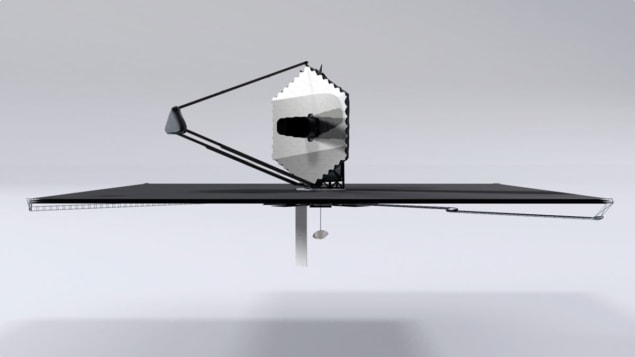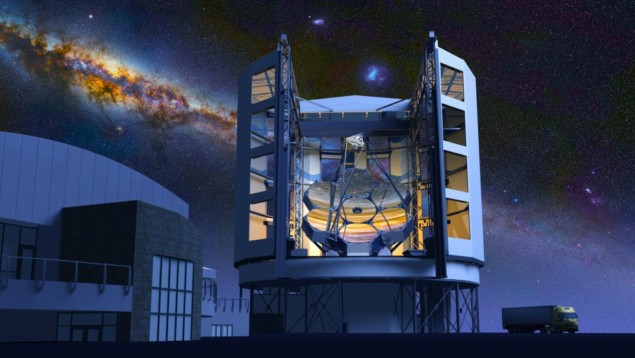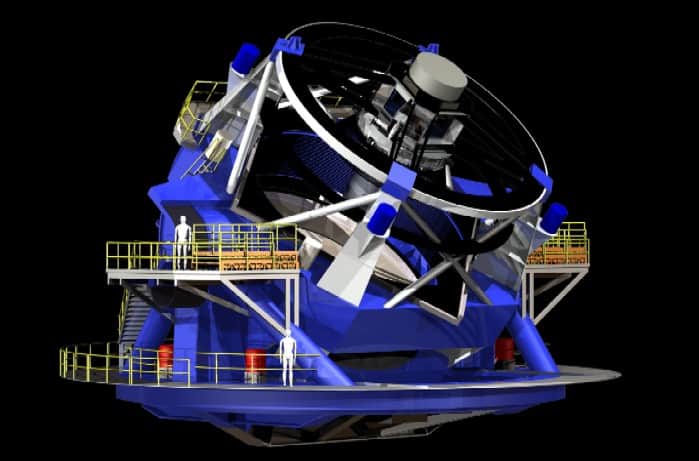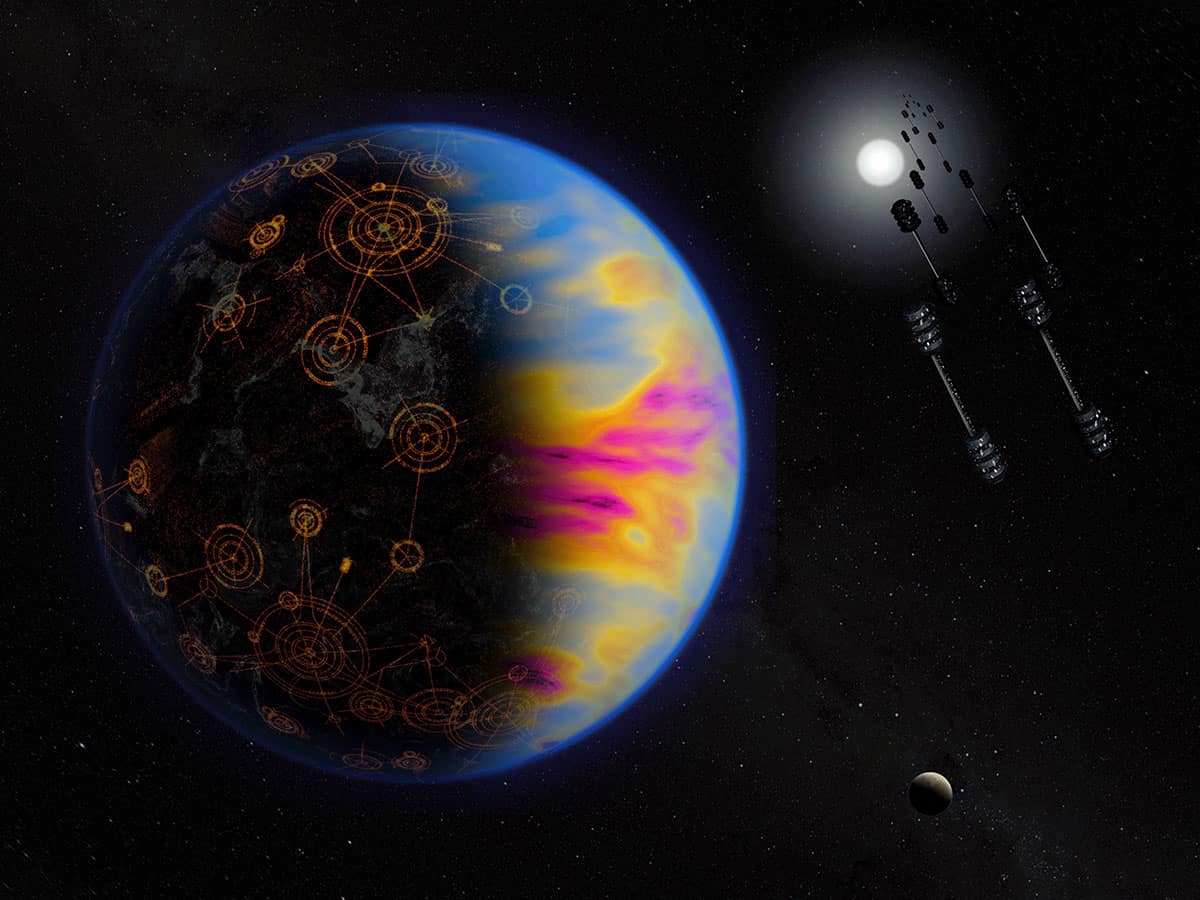Astro2020 Decadal Survey calls for ‘great observatory’ to succeed Hubble
04 Nov 2021 Michael Banks
Michael Banks reveals the highlights of the long-awaited Astro2020 Decadal Survey, which will define the course of astronomy and astrophysics in the US and beyond over the next 10 years.

An influential panel of astrophysicists and astronomers has called for a major space-based observatory to be launched in the mid-2040s. This significant new mission would observe extra-solar planets that are 10 billion times fainter than the stars they orbit and provide spectroscopic data about the planets. The recommendation is made in a major, 614-page report released today by the Decadal Survey on Astronomy and Astrophysics 2020, known as Astro2020.
Dubbed the “real” successor to the ageing Hubble Space Telescope, the observatory would contain a mirror with a diameter of at least 6 metres and cost around $11bn. The 20-member panel that wrote the report says that an independent review of the project’s feasibility should, however, be carried out before it is given the green light. Such a review would prevent the project from suffering the cost hikes and delays that have hit previous large space-based observatories.
Entitled Pathways to Discovery in Astronomy and Astrophysics for the 2020s, the decadal survey was written by a committee convened by the US National Academies of Sciences, Engineering, and Medicine. Co-chaired by Fiona Harrison from the California Institute of Technology and Robert Kennicutt from the University of Arizona and Texas A&M University, it is the seventh decadal survey of its type. Astro2020 identifies the highest priority research activities in astronomy and astrophysics in the US over the coming decade.
The new report broadly identifies three “priority scientific areas” for investment over the next decade. One is to identify and characterize Earth-like planets outside the solar system, with the goal of imaging potentially habitable worlds. A second is to probe the nature of black holes and neutron stars. The third area is understanding what happened in the earliest moments in the universe and to improve our understanding of the origins and evolution of galaxies.
The main aim of the proposed observatory – which is the highest-ranked large space-based mission in the report – would be to search for biosignatures from some 25 habitable zone planets and to be a “transformative facility for general astrophysics”. Hubble, which covers wavelengths from ultraviolet to near infra-red, has been in operation in low-Earth orbit for over 30 years but has recently suffered a series of failures in its electronics systems that could limit its lifetime.
The next big thing One for the future: the Large UV/Optical/IR Surveyor (LUVOIR) is a multi-wavelength space observatory under consideration in NASA’s Astro2020 decadal survey. (Courtesy: NASA)
One for the future: the Large UV/Optical/IR Surveyor (LUVOIR) is a multi-wavelength space observatory under consideration in NASA’s Astro2020 decadal survey. (Courtesy: NASA)
 One for the future: the Large UV/Optical/IR Surveyor (LUVOIR) is a multi-wavelength space observatory under consideration in NASA’s Astro2020 decadal survey. (Courtesy: NASA)
One for the future: the Large UV/Optical/IR Surveyor (LUVOIR) is a multi-wavelength space observatory under consideration in NASA’s Astro2020 decadal survey. (Courtesy: NASA)The two leading mission concepts in the infrared, optical and ultraviolet that are currently being worked on as a potential Hubble successor are the Large Ultraviolet Optical Infrared Surveyor (LUVOIR) observatory and the Habitable Exoplanet Imaging Mission (HabEx) telescope. LUVOIR has two variants, differing only in terms of the size of the primary mirror.
The panel says, however, that LUVOIR-A – which would feature a huge 15 m-diameter mirror made up of 36 segments – is too expensive an option. LUVOIR-B, in contrast, would contain a smaller, 8 m mirror and cost only £17bn. It features both a coronagraph and starshade that block out the light from a star so that nearby objects can be resolved. HabEx, meanwhile, is also designed to have a coronagraph and starshade, but with a 4 m diameter primary mirror would cost only $10.5bn. A smaller version of HabEx featuring a 3.2 m mirror would have an even lower price tag of $7.8bn.
The report says that the implementation of a single telescope based on the LUVOIR and HabEx concepts could begin by the end of the decade following a review to consider whether it is ready for implementation. Julianne Dalcanton from the Univeristy of Washington, who sits on Astro2020’s steering committee, told Physics World that the new telescope would be “the result of an intensive design and technology development process that would begin immediately”. She adds that it would “take advantage of the hard work of both the LUVOIR and HabEx concepts, pulling together the best of both to launch a large, capable telescope”.
The new telescope will take advantage of the hard work of both the LUVOIR and HabEx concepts, pulling together the best of both.Julianne Dalcanton, University of Washington
Theoretical cosmologist Michael Turner from the University of Chicago, who has been involved in four decadal surveys and who was a reviewer on the latest incarnation, told Physics World that LUVOIR will do a “panoply of exciting science”. Turner adds that the launch date of early 2040 is daunting. “But as they say all the easy stuff has been done, and the ambitious plans we have these days take a long time to implement,” he adds. “But I believe [they are] worth waiting for.”
Those involved in the LUVOIR mission are equally delighted by the support from the decadal committee. Martin Barstow, a space scientist from the University of Leicester in the UK, who is a member of LUVOIR’s planning team, says the announcement is “a really exciting result” for the search for habitable worlds and life elsewhere in our galaxy, which he says is “one of the most important scientific quests”.
A mission like LUVOIR is the tool we need, and I will look forward to having that answer to the question “are we alone” within my lifetimeMartin Barstow, University of Leicester
Barstow adds that seeing LUVOIR so prominently in the decadal survey is a “testament to the huge effort of the team” over the past few years. “[Exoplanet research] is enormously challenging from an engineering perspective, yet we know how to carry out the search and are close to having the technology with which to do it,” adds Barstow. “A mission like LUVOIR is the tool we need, and I will look forward to having that answer to the question “are we alone” within my lifetime.”READ MORE

As well as LUVOIR and HabEx, two other large space-based missions were selected by NASA in 2016 to go forward into the Astro2020 process. They are the Lynx X-ray Observatory, which would replace the Chandra X-ray observatory that was launched in 1999. The other is Origins – an infrared space telescope. The committee recommend that NASA begin preliminary studies on both these missions, which would have a target launch cost of between $3-5bn. However, it states that the next decadal survey should decide which one enters the implementation phase.
Chanda Prescod-Weinstein, a theoretical cosmologist from the Univeristy of New Hampshire, is, however, disappointed by the decision to delay a potential go-ahead for Lynx as well as the general lack of emphasis on dark matter given its critical role in the universe particularly in galaxy dynamics. “Perhaps the most disconcerting thing here is the delayed start for the proposed preliminary study for the X-ray mission – I don’t see a reason to wait,” says Prescod-Weinstein. “There’s been a lot of emphasis on optical, but it is also something we can do from the ground and where we already have new missions in the pipeline. We can’t do X-ray from the ground.”
Planning ahead
Another major recommendation in the Astro2020 report is that NASA should establish a dedicated programme to develop the science, mission architecture, and technologies of large mission that are identified as high priority. The so-called “Great Observatories Mission and Technology Maturation Programme” would advance the designs of several major overlapping space missions in the coming decades and provide early investment in the development of multiple mission concepts, changing the way major projects are planned and developed. A Hubble successor would be the first mission to enter this programme.
Making up-front investments helps create mature missions with well-understood trade-offs between science and costJulianne Dalcanton, Univeristy of Washington
It is hoped that the programme will lower the risks and costs of projects before they become too complex and expensive. The move is partly since the highest-ranked space telescopes in previous decadal surveys remain on the ground. Astro2000’s top-ranked space project was the $11bn James Webb Space Telescope (JWST), which is finally expected to launch next month following years of delays and budget overruns.
In the 2010 decadal survey, meanwhile, astronomers chose the $3.5bn Wide-Field Infrared Survey Telescope, which then was set to launch in 2020. Planning issues took hold of that project too and the scope of the mission was cut down and it was also renamed the Nancy Grace Roman Space Telescope with a projected launch date of 2025. Both are primarily infra-red telescopes so not seen as a direct successor to Hubble.
“Making up-front investments helps create mature missions with well-understood trade-offs between science and cost and allows NASA to move a sequence of exciting missions forward to launch at a faster cadence than possible if they were developed completely sequentially,” says Dalcanton.
Eye on the sky The $1bn Giant Magellan Telescope will be located at Las Campanas in Chile’s Atacama Desert and will have seven circular mirrors, each 8.4 m in diameter and weighing 18 tonnes (Courtesy: Giant Magellan Telescope – GMTO Corporation)
The $1bn Giant Magellan Telescope will be located at Las Campanas in Chile’s Atacama Desert and will have seven circular mirrors, each 8.4 m in diameter and weighing 18 tonnes (Courtesy: Giant Magellan Telescope – GMTO Corporation)
 The $1bn Giant Magellan Telescope will be located at Las Campanas in Chile’s Atacama Desert and will have seven circular mirrors, each 8.4 m in diameter and weighing 18 tonnes (Courtesy: Giant Magellan Telescope – GMTO Corporation)
The $1bn Giant Magellan Telescope will be located at Las Campanas in Chile’s Atacama Desert and will have seven circular mirrors, each 8.4 m in diameter and weighing 18 tonnes (Courtesy: Giant Magellan Telescope – GMTO Corporation)For the past two decades two competing designs have been battling it out to become the next US large ground-based facility. They are the Giant Magellan Telescope (GMT) and Thirty Meter Telescope (TMT). The $1bn GMT will be located at Las Campanas in Chile’s Atacama Desert and is on-track for first light in 2029. The GMT will have seven circular mirrors, each 8.4 m in diameter and weighing 18 tonnes. When put together, they will create a telescope equivalent to one mirror 25.4 m wide that has a total collecting area of 368 square metres. The telescope will have space for 10 instruments and can complete a full rotation in nearly three minutes.
The TMT, meanwhile, is designed to have a primary mirror 30 m across made of 492 hexagonal segments enclosed in a structure 66 m wide and 56 m tall, when built the TMT will be able to collect images 12 times sharper than the Hubble Space Telescope, allowing it to resolve the faintest and oldest galaxies. Construction began in 2014 but was halted a year later as native Hawaiians protested over how the astronomical community approached building the telescope on Mauna Kea, which they regard as sacred. Since then, TMT officials have chosen a site in La Palma should it not be possible to build in Hawaii.READ MORE

Rather than pick one of these telescopes, the report says the National Science Foundation (NSF) should invest in both the GMT and TMT to “ensure significant access to these tools for the entire US astronomical community”. The report notes that the scientific potential of these observatories is “transformative, with the ability to address all three of the scientific priority areas and complement current and future space telescopes”. However, the report recommends that the NSF conduct an external review of the TMT and GMT by 2023 and if only one of these instruments can meet certain conditions, then the NSF should “proceed with investment in that project alone”.
If both are chosen for support then US-based astronomers should receive at least 25% of the time on each telescope but if only one project proves to be viable, NSF should aim to achieve “a larger fraction of the time, in proportion to its share of the costs and up to a maximum of 50%”. “Investing in both telescopes is the ideal outcome for truly transformative science, provided both can be successful,” adds Dalcanton. “Rather than picking a winner and loser, the report offers a framework for evaluating whether the telescopes meet needed milestones before triggering federal investment.”
Turner says that given the progress of the 40 m-diameter European Extremely Large Telescope, which is currently under construction in Chile, the US has fallen behind Europe in the realm of big ground-based telescopes “just at a time when the opportunities for discoveries has never been greater”. He adds that the support by the panel is “essential” to the future of US leadership in astronomy and astrophysics. “Not only will NSF involvement give access to all US astronomers, but it comes at a time when both projects are in need of financial help,” adds Turner. “In the US, I believe we are transitioning from our traditional private support of big telescopes to public support. This will help this transition”.
The most exciting breakthroughs in all of science are occurring in astrophysics and the life and biological sciences. What a great time to be a scientistMichael Turner, University of Chicago
GMT President Robert Shelton, meanwhile, says the GMT collaboration has been “deeply gratified by the enormous US and global support we have received from the scientific and philanthropic communities”. “We are also incredibly grateful to everyone who contributed to the Decadal Survey process,” he says. “While we have much work still to do, we take great pride in what we’ve already achieved.”
Another ground-based project that is recommended in the report is the cosmic microwave background experiment, known as CMB-S4. The report calls for the NSF and the US Department of Energy (DOE) to “jointly pursue the design and implementation” of CMB-S4. “This endorsement recognizes the enormous CMB prize still out there and the continuing potential of stunning science to come from the CMB,” says Turner. “The big prize of course is the B-mode polarization signature of inflation that would reveal when inflation took place.”
Community focus
Astro2020 was expected to be released last year but was postponed due to the impact of the COVID-19 pandemic and many subsequent meetings had to be moved online just at the time when the process was at the peak time for activities. Astro2020 includes the input of over 150 scientists and drew from the astronomical community through hundreds of white papers, town hall meetings, and the advice of 13 sub-panels. These included six science panels and six programme panels as well as the first panel focussed on the state of the profession and societal impacts.
Indeed, astronomy has been hit by several issues recently from scientific misconduct to a failure to address concerns of indigenous people when building new telescopes, which has affected the TMT. The report recommends that the astronomy community should work with experts from other “experienced disciplines” such as archaeology and social sciences and representatives from local communities to define a “community astronomy model of engagement” that advances scientific research while “respecting, empowering and benefiting local communities”.READ MORE

The report also calls for funding agencies to improve the diversity of the astronomical community, describing the current racial/ethnic diversity among astronomy faculty in the US as remaining “abysmal”. It calls on NASA, NSF and the DOE to “ensure their policies treat harassment and discrimination as forms of scientific misconduct, and invest in workforce diversity at the division and directorate levels — as well as consider including the diversity of project teams and participants as a criterion when awarding funding”.
Dalcanton says that many students go through their entire academic lives without being taught by faculty who share their lived experiences and who could serve as models “for a future that would treasure their contributions”. “Building intellectual communities that anyone can find a home in will always bring forward the best science,” adds Dalcanton. “Most faculty funding goes towards supporting students and trainee scientists, and money spent to help those faculty build diverse communities of scholars lays a foundation for future discoveries.”
That view is backed by Prescod-Weinstein who says she is “excited” to see a call for graduate and postdoctoral fellowships to improve diversity and inclusivity. “So many of us have asked for these over the years,” adds Prescod-Weinstein. “I agree that broadening participation at the faculty level is also critical. And it is good to see an emphasis on taking harassment seriously.” Yet she says that the devil will be in the detail. “I will be interested to see proposed execution and whether the changes are cosmetic or substantive, with a chance of having real, lasting impact”.
Dalcanton says that the report sets out a clear and “ambitious” vision for the coming decade – a view that is shared by Turner. “The most exciting breakthroughs in all of science are occurring in astrophysics and the life and biological sciences,” adds Turner. “Both are transforming our understanding of our place in it all — and both are powered by instrumentation that is enabling us to be able to explore two these worlds that have been beyond our reach. What a great time to be a scientist!”
from physicsworld.com 4/11/2021
Δεν υπάρχουν σχόλια:
Δημοσίευση σχολίου